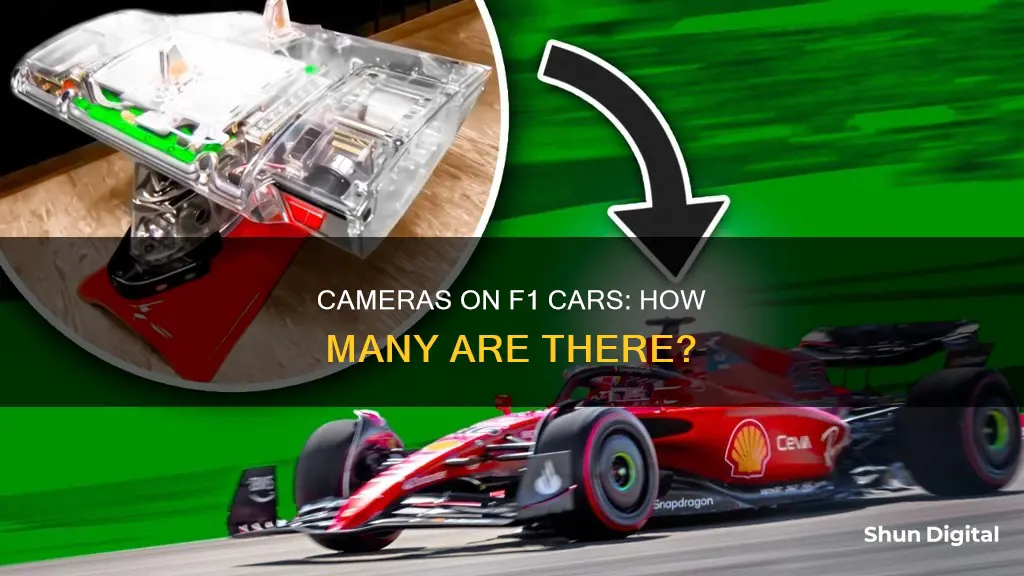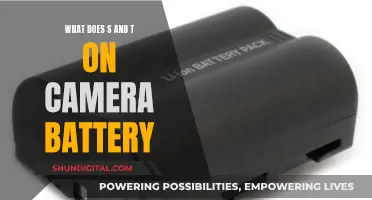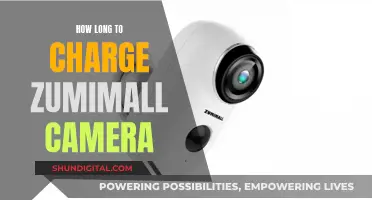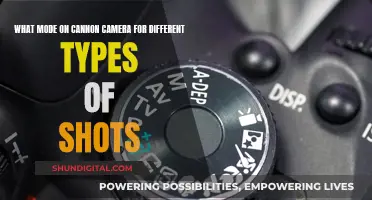
Formula 1 cars are equipped with a range of cameras to capture the action from various angles and provide viewers with an immersive experience. The number of cameras on an F1 car can vary, with some sources stating 5 or 9 cameras, while others mention 6 camera mounting points. These cameras are strategically placed to capture the speed and intensity of the race, giving viewers a front-row seat to the exhilarating world of F1 racing.
| Characteristics | Values |
|---|---|
| Number of cameras on F1 car | 9 |
| Camera locations | On top of the car, front of the car, rear, sides of the chassis, cockpit, and inside the driver's helmet |
| Purpose | To provide viewers with a top-down, forward-facing view, to show the driver's perspective, and to capture the action on the track |
| Functionality | Each camera has its own processor and can run on power supplied by the car or an internal battery, allowing for up to 20 minutes of recording even when the car is turned off or crashed |
| Camera types | Grass Valley cameras, Canon broadcast lenses, slow-motion cameras, 360-degree cameras, helmet cameras, and drone cameras |
| Additional equipment | Microphones to capture engine sound and crash audio |
What You'll Learn
- F1 cars have nine cameras each, including a driver-facing one and a 360-degree camera
- Cameras are placed in the cockpit, on the chassis, and on the nose of the car
- The in-helmet camera is the most complex, with a lens mounted to the right side of the driver's head
- Cameras have their own processors and can record for 15-20 minutes without power
- F1 broadcasting involves over 120 cameras, microphones, and drones to capture the action

F1 cars have nine cameras each, including a driver-facing one and a 360-degree camera
F1 cars are equipped with nine cameras each, offering viewers unmatched coverage of the races. The cameras are placed at various points on the car, including the chassis, the nose, the rear impact structure, and the cockpit.
The "T-cam" is the most recognisable camera, found in the "T" structure that sits on top of every F1 car. It provides viewers with a top-down, forward-facing view that is often used by broadcasters. There are two of these cameras, with one pointing forward and the other backward.
In addition to the "T-cam", there are two nose cameras at the front of the car and a rear-facing camera mounted on the rear impact structure. Two more cameras are positioned on either side of the chassis behind the driver, capturing the action from the side.
One of the most notable cameras is the driver-facing camera located in the cockpit, offering a close-up view of the driver's expressions and reactions during the race. This camera provides valuable insights into the driver's experience and can even capture their heart rate and other biometric data.
Furthermore, F1 cars feature a 360-degree camera mounted on the body in front of the driver. This camera captures incredible footage from all angles, providing a dynamic perspective of the race.
The in-helmet camera is another impressive piece of technology. It is mounted on the right side of the driver's head, embedded into the helmet, and connected to the car via a cable. This camera provides a unique point of view, allowing viewers to see exactly what the driver sees.
The cameras on F1 cars are not just for broadcasting purposes. They also serve an important safety function, with some capable of recording footage for 15 to 20 minutes even if the car is turned off or involved in a crash. This helps teams and organisers analyse accidents and improve safety measures.
Surveillance Cameras in Florida: Are They Legal?
You may want to see also

Cameras are placed in the cockpit, on the chassis, and on the nose of the car
Cameras are strategically placed on an F1 car to provide viewers with a variety of perspectives and enhance their overall viewing experience. One of the key locations for cameras is the cockpit, which offers a bird's-eye view of the drama unfolding inside. This camera angle allows viewers to see the driver's every move, feel the bumps on the track, and witness how close the driver comes to the barriers on tight circuits.
Additionally, cameras are placed on the chassis of the F1 car. These cameras provide a unique perspective, capturing the driver's face, hands, and feet, as well as the changing of gears. This angle gives viewers a sense of the driver's focus and intensity during the race.
Another critical location for cameras is the nose of the car. Nose cameras are typically placed right at the front of the vehicle, providing a forward-facing view. This angle offers a thrilling sensation of speed and allows viewers to see what the driver is facing on the track.
The placement of cameras on the cockpit, chassis, and nose of the F1 car ensures that viewers at home and trackside can experience the race from multiple vantage points, bringing them closer to the action and providing a more immersive viewing experience.
Unleash Camera Raw: Bridge's Hidden Gem
You may want to see also

The in-helmet camera is the most complex, with a lens mounted to the right side of the driver's head
The in-helmet camera is a tiny but complex piece of technology. Known as the 'Driver's Eye', it is an FIA-homologated micro-camera that is eight millimetres in diameter and weighs between 1.43 grams and 2.5 grams. This camera is positioned at eye-level on the protective padding inside the driver's helmet, with the lens mounted to the right side of the driver's head.
The camera is wired to a control unit powered by the car, and the standard F1 hardware transmits the camera feed. The helmet and camera wiring are homologated to meet FIA safety regulations. The camera is connected to the car via a cable that hangs from the helmet and connects to the car's wiring harness. This setup allows the camera to continue recording for 15 to 20 minutes even if the car is turned off or crashes.
The in-helmet camera provides viewers with a unique perspective: a true first-person view of the driver's experience through their visor. This offers an immersive experience, showcasing the nearly superhuman reflexes of F1 drivers as they navigate high-speed races.
The use of in-helmet cameras in F1 races has evolved over time. Initially introduced in 1994, the technology has advanced, and since 2023, all drivers have been equipped with these cameras, providing a more widespread first-person perspective during races.
While some viewers criticise the shakiness and poor image quality of the in-helmet camera footage, others find it thrilling and immersive, offering a glimpse into the intense world of F1 racing.
Understanding the Note 8 Camera's Unique Mode
You may want to see also

Cameras have their own processors and can record for 15-20 minutes without power
Formula 1 cars are equipped with nine cameras each, capturing footage from various angles and providing viewers with unmatched broadcast coverage. These cameras are not just limited to capturing footage during the race but also have their own processors and power supply systems, making them highly advanced technological components.
One of the most impressive features of these cameras is their ability to continue recording even when the car is turned off or in the event of a crash. Each camera has its own processor that can determine its power source, either from the car or an internal battery. This ensures that the cameras can still record footage for 15 to 20 minutes without power from the vehicle, providing valuable data and insights after a race or incident.
The cameras' ability to switch power sources ensures that critical moments are captured, such as the aftermath of a crash or when the car is stationary. This functionality is particularly useful for post-race analysis, allowing teams and officials to review events, make informed decisions, and enhance spectator experience.
The in-helmet camera, mounted on the right side of the driver's head, is a standout component. Its complexity lies in the collaboration required between F1 and helmet manufacturers to embed a processor into the helmet while ensuring the safety of the driver. The camera connects to the car's wiring harness via a cable, providing a unique perspective of the race from the driver's viewpoint.
In addition to the nine cameras, Formula 1 cars also have two microphones mounted on the body, capturing engine sounds and any crashes. This comprehensive setup ensures that every moment of the race can be recorded and broadcasted to viewers worldwide, providing an immersive and captivating viewing experience.
Computer Cameras: Are Microphones Always Listening?
You may want to see also

F1 broadcasting involves over 120 cameras, microphones, and drones to capture the action
F1 broadcasting is an immense operation that involves over 120 cameras, microphones, and drones to capture the action from various angles and bring it to viewers worldwide. The process of filming and broadcasting an F1 race is challenging and requires a lot of technology, staff, and hard work.
To capture the race, F1 broadcasting utilizes a combination of trackside cameras, onboard cameras, and aerial footage. There are typically 23 to 28 ultra high-definition cameras installed trackside at various points around the circuit, complemented by 10 cameras in the pit lane. These cameras provide crucial track-level shots and capture the intense action of the race.
In addition to the trackside cameras, F1 cars are equipped with onboard cameras that offer a unique perspective from within the cockpit. Each car usually has at least five cameras, including the "T-cam" on top of the car, which has two lenses pointing forward and backward. Three additional cameras are positioned at different locations on the chassis, capturing the tires, the rear wing, or offering a view back at the driver. These onboard cameras are small, lightweight, and in some cases, provide 360-degree footage.
Aerial footage is an essential component of F1 broadcasting, providing dynamic and steady shots from above. This is achieved through the use of helicopter cameras and, more recently, drones. The helicopter camera, introduced in the 1990s, utilizes advanced stabilization technology to capture smooth and interesting footage as the helicopter moves above the circuit. Drones, on the other hand, provide a closer aerial view and have been experimented with in certain races, but they pose safety concerns and are not yet a regular fixture in F1 broadcasting.
The audio aspect of F1 broadcasting is just as important as the visual. To capture the sounds of the cars and the atmosphere of the race, hundreds of high-quality microphones are placed around the circuit. These microphones are separate from the ones on the cameras and are designed to enhance the audio experience for viewers.
The footage and audio from all these sources are then seamlessly combined and produced by a dedicated broadcast team, who work tirelessly to ensure that viewers at home can experience the thrill and excitement of F1 racing.
Focusing Camera at Night: Tips for Sharp Nighttime Photos
You may want to see also
Frequently asked questions
F1 cars have nine cameras whenever they're racing.
The most recognisable camera is the "T-cam" that sits on top of the car, giving a top-down, forward-facing view. There are two nose cameras at the front of the car, a rear-facing camera, two cameras mounted to either side of the chassis behind the driver, a driver-facing camera in the cockpit, a 360-degree camera in front of the driver, and a camera inside the driver's helmet.
The cameras provide onboard TV footage, giving viewers an unmatched perspective of the race and a sense of what the driver sees and feels.
The cameras have six possible mounting points, with one always positioned on top of the airbox behind the driver's head. The FIA chooses the position of the second camera in consultation with the team and driver.







